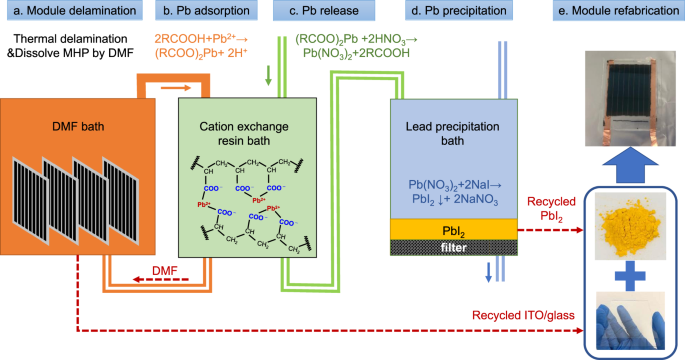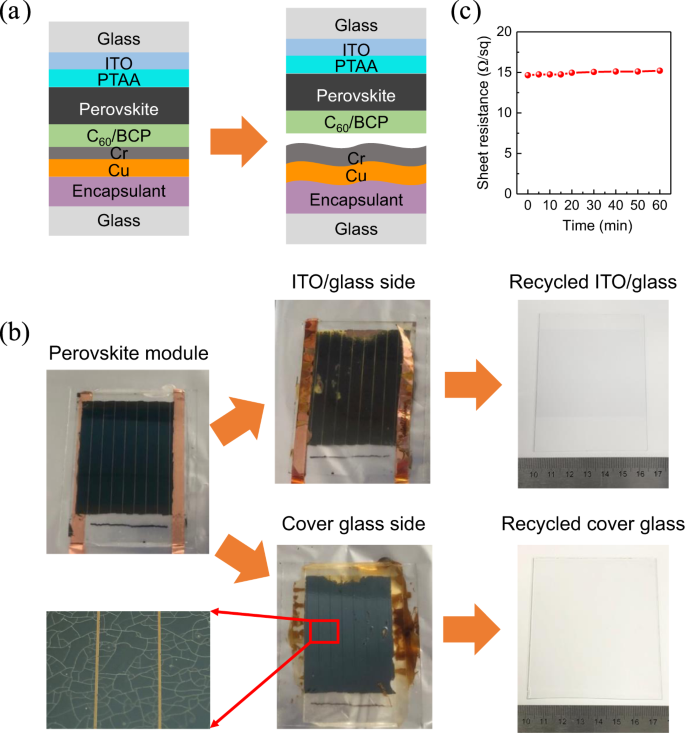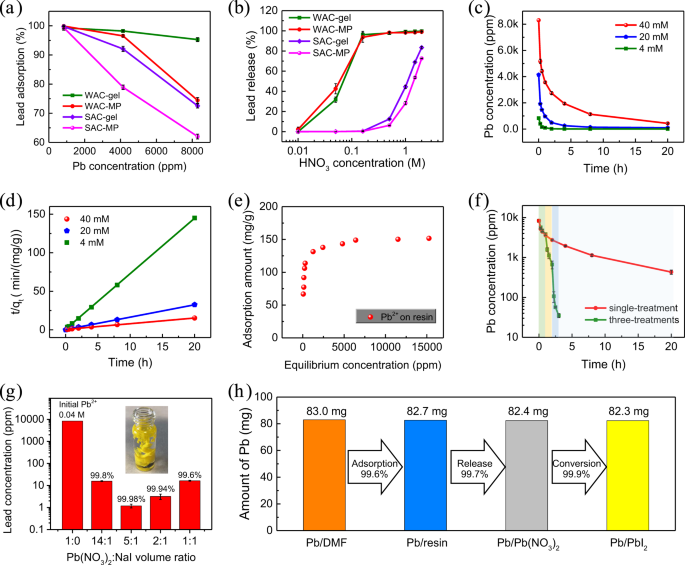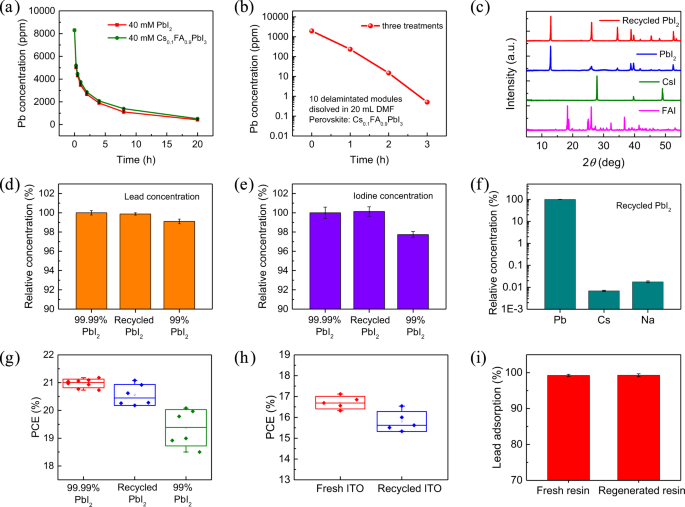Recycling roadmap
The proposed roadmap to recycle toxic lead and valuable glass substrates from perovskite solar modules is sketched in Fig. 1. After the delamination of encapsulated perovskite solar modules, the lead in perovskite layer is dissolved by organic solvent, such as dimethylformamide (DMF). Lead ions are first adsorbed by a lead adsorbent to fully remove lead in the organic solvent, and then are released to clean solvent, followed by a precipitation to PbI2 for reuse. In this study, we chose carboxylic acid cation-exchange resin as adsorbent to recycle lead in decommissioned perovskite solar modules. The lead-adsorption process and lead-release process on resins are based on ion exchange between H+ ions and Pb2+ ions:
$$2{{{{{rm{R}}}}}}-{{{{{rm{COOH}}}}}}+{{{{{{rm{Pb}}}}}}}^{2+}leftrightarrow {left({{{{{rm{R}}}}}}-{{{{{rm{COO}}}}}}right)}_{2}{{{{{rm{Pb}}}}}}+{2{{{{{rm{H}}}}}}}^{+}$$
(1)
a Encapsulated perovskite solar modules were delaminated and MHP was dissolved by DMF. b Lead ions in DMF were removed by carboxylic acid cation-exchange resin. c The adsorbed lead ions on resin were released to aqueous solution by resin-regeneration process via HNO3. d Precipitation of PbI2 by pouring NaI into Pb(NO3)2 containing solution. e Module refabrication based on recycled materials.
It is noted that the ion-exchange process is a reversible reaction. A high concentration of H+ ions in solution could reverse the equilibrium in equation (1), which is a resin-regeneration process and thus can be used for lead release. Typical regenerant for cation-exchange resins is high-concentration HCl or H2SO4 acid solution. Considering PbCl2 and PbSO4 have low solubility in aqueous solution, regeneration by HCl and H2SO4 could directly precipitate the released Pb2+ ions as PbCl2 and PbSO4, respectively, which cause difficulty to separate lead with resin. Here, we chose HNO3 aqueous solution as regenerant to release the adsorbed lead ions as water-soluble Pb(NO3)2. Because PbI2 is the main lead source for most of highly efficient perovskite solar cells, the best form of recycled lead for reusing is PbI2 Therefore, the lead is converted from Pb(NO3)2 to PbI2 precipitation by adding low-cost NaI due to their solubility difference in aqueous solution.
Module delamination
To recycle the end-of-life perovskite solar modules, the first step is to develop a delamination technique to disassemble the encapsulated modules in order to expose the perovskite layer. Here we consider the perovskite module structure fabricated on indium tin oxide (ITO) glass and encapsulated with another piece of glass and encapsulant. The existing encapsulants for perovskite solar cells include epoxy resin, polyolefin, Surlyn, polyisobutylene, polyurethane, etc., together with a back cover glass which can effectively prevent the permeation of moisture, oxygen, and other hazards38,39,40,41. This is the most likely structure in commercial perovskite solar modules that gives best stability, and was thus chosen for this study. We discovered that a short thermal treatment at high temperature can effectively disassemble the encapsulated perovskite solar modules and obtain both intact ITO glass and back cover glass. After thermal stress at 250 °C for 2 min, the polymer encapsulant was melt, which created a strain to delaminate the perovskite solar module at the interface of electron-transport layer (ETL) and metal electrode, such as epoxy resin as encapsulant in Fig. 2. The lead halide perovskite films and ETL stayed at the ITO/glass side, then ETL was washed by 1,2-dichlorobenzene (DCB), and lead halide perovskite was dissolved in DMF for subsequent lead recycling (Fig. 2b). After washing away the hole-transport layer and other residuals, ITO/glass could reuse for module refabrication. We found no noticeable conductivity changes for the ITO/glass substrate after recycling process. Even after annealing at 250 °C for 1 h, the conductivity of ITO/glass only slightly increased from 14.6 Ω/sq to 15.2 Ω/sq (Fig. 2c). The Cr and Cu electrodes with the encapsulant stayed at back cover-glass side, where 30 nm of Cr layer on the top surface induced a black color and electrode/encapsulant film formed winkles after thermal stress (Fig. 2b). The encapsulant and metal electrode were scraped by a knife when the encapsulant was still soft, and then the back cover glass was cleaned for reuse.
a Schematic illustration for delamination at the interface of electron-transport layer and metal electrode. b Photo of an encapsulated perovskite solar module, delaminated module at ITO/glass side and back cover-glass side, and recycled ITO/glass and cover glass after cleaning. The front glass size is 8.5 cm × 6.5 cm. c Change of sheet resistance for ITO/glass substrate after thermal annealing at 250 °C for 1 h under ambient atmosphere.
Cation-exchange resins for lead recycling
It is crucial to find a material with both high lead-adsorption efficiency from waste solution and high lead release ratio for the purpose of efficient lead recycling. We previously demonstrated that a cation-exchange resin layer integrated into the perovskite layer and onto the electrode can effectively avoid lead leakage when the modules are broken, where the strongly acidic cation-exchange resin with strong bonding between sulfonic acid and lead displayed excellent lead trapping effect21,22. We would like to start with the demonstrated lead adsorbent that can retain lead in perovskite modules during its operation lifetime. However, we find that the choice of lead absorber for lead cycling is different from previous studies for lead trapping, because it needs to release lead ions in this case where a lead absorber with appropriate bonding strength with lead may be preferred. Figure 3a–b compares the lead recycling performance using weakly acidic cation (WAC)-exchange resins with functional group of carboxylic acid based on both gel and macroporous (MP) matrix structures, and strongly acidic cation (SAC)-exchange resins with functional group of sulfonic acid based on gel and MP matrix. For 10 mL of 4 mM PbI2 (lead concentration of 830 parts per million (ppm)) in DMF, all four types of cation-exchange resins adsorbed more than 99.2% of Pb2+ ions from DMF solution after stirring with 1 g of resin for 20 h (Fig. 3a). When the initial lead concentration was increased to 40 mM, WAC-gel remained a high lead-adsorption ratio of 95%, while lead-adsorption ratio for other three cation-exchange resins dropped to less than 80% (Fig. 3a). For the lead-release process using HNO3 regenerant, Fig. 3b shows the carboxylic acid cation-exchange resins WAC-gel and WAC-MP both released most of adsorbed Pb2+ ions after 30 min of regeneration when the concentration of HNO3 regenerant is higher than 0.16 M. However, the sulfonic acid cation exchange resins SAC-gel and SAC-MP both showed a low lead-release ratio even when the concentration of HNO3 regenerant was up to 2 M (Fig. 3b).
a Lead-adsorption ratio of 10 mL different concentrations of PbI2 solution in DMF after stirring with 1 g of cation-exchange resins for 20 h. b Lead-release ratio of 1 g of cation-exchange resins under different concentrations of HNO3 for 30 min. c Adsorption kinetics and (d) second-order kinetic fit for lead adsorption onto WAC-gel resin at different initial Pb concentrations. e The relation of adsorbed lead amount and equilibrium Pb2+ ion concentration in DMF solution, after adsorption for three days. f Lead adsorption for 10 mL of 40 mM lead in DMF by WAC-gel single treatment and three treatments. Single treatment was carried out with 1 g of WAC-gel for 20 h. Three treatments were carried out with 1 g of WAC-gel for 1 h, then the left PbI2 solution was transferred to 1 g of fresh resin for the second and third treatment. g Lead concentration in solution after mixing 0.04 M Pb(NO3)2 and 1.5 M NaI with different volume ratio. The inset is a photo of 1.5 M NaI solution dropped into Pb(NO3)2 containing solution. h Lead recycling ratio of 10 mL of 40 mM PbI2 in DMF by WAC-gel three treatments, lead release by HNO3 solution for 30 min, and lead conversion by reaction with NaI solution. The error bars in (a), (b), (c), (f), and (g) represent the standard deviation for three samples.
The large total capacity of WAC resin and its high affinity for hydrogen ions are crucial to achieve both high lead-removal ratio during adsorption process and high lead-release ratio during regeneration process. The ion exchange between H+ and Pb2+ undergoing reversible reaction as shown in equation (1) and the equilibrium constant ({K}_{{rm {H}}^{+}}^{{{{{{rm{Pb}}}}}}^{2+}})can be defined as:
$${K}_{{{{{{rm{H}}}}}}^{+}}^{{{{{{rm{Pb}}}}}}^{2+}}=frac{{left[{{{{{rm{Pb}}}}}}^{2+}right]}_{r}times {left[{{{{{rm{H}}}}}}^{+}right]}_{s}^{2}}{{left[{{{{{rm{Pb}}}}}}^{2+}right]}_{s}times {left[{{{{{rm{H}}}}}}^{+}right]}_{r}^{2}}$$
(2)
where ({left[{{{{{{rm{Pb}}}}}}}^{2+}right]}_{{{{{{rm{r}}}}}}}) and ({left[{{{{{{rm{H}}}}}}}^{+}right]}_{{{{{{rm{r}}}}}}}) is the concentration of Pb2+ and H+ ions on resin, respectively, and ({left[{{{{{{rm{Pb}}}}}}}^{2+}right]}_{{{{{{rm{s}}}}}}}) and ({left[{{{{{{rm{H}}}}}}}^{+}right]}_{{{{{{rm{s}}}}}}}) is the concentration of Pb2+ and H+ ions in solution, respectively. The ratio of Pb2+ concentration on resin and Pb2+ concentration in solution is characterized with a distribution coefficient D:
$$D=frac{{left[{{{{{rm{Pb}}}}}}^{2+}right]}_{r}}{{left[{{{{{rm{Pb}}}}}}^{2+}right]}_{s}}={K}_{{{{{{rm{H}}}}}}^{+}}^{{{{{{rm{Pb}}}}}}^{2+}}times frac{{left[{{{{{rm{H}}}}}}^{+}right]}_{r}^{2}}{{left[{{{{{rm{H}}}}}}^{+}right]}_{s}^{2}}$$
(3)
A large D value is needed for lead-adsorption process and a small D value is preferred during regeneration process, where the concentration difference of H+ on resin and in solution is also important besides ({K}_{{{{{{rm{H}}}}}}^{+}}^{{{{{{rm{Pb}}}}}}^{2+}}) value. In lead-adsorption process, the large difference of H+ ion concentration on resin ({left[{{{{{{rm{H}}}}}}}^{+}right]}_{{{{{{rm{r}}}}}}}) and in solution ({left[{{{{{{rm{H}}}}}}}^{+}right]}_{{{{{{rm{r}}}}}}}) generates a large D value for efficient adsorption of Pb2+ ions. The WAC-gel and WAC-MP resin in this study has a high total capacity (total active H+ sites on resin) of 4 eq/L (equivalents per liter of resin), which is larger than the total capacity of 1.9 eq/L for SAC-gel resin and 1.7 eq/L for SAC-MP resin. This large ({left[{{{{{{rm{H}}}}}}}^{+}right]}_{{{{{{rm{r}}}}}}}) on WAC resin explains its excellent lead-adsorption performance. During the resin-regeneration process, the high H+ ion concentration in HNO3 solution ({left[{{{{{{rm{H}}}}}}}^{+}right]}_{{{{{{rm{s}}}}}}}) decreases the D value, thus releasing Pb2+ ions. The major difference between the WAC resin and SAC resin is their affinity of Pb2+ ions compared with H+ ions. Due to different acid-dissociation constant, the ({K}_{{{{{{rm{H}}}}}}^{+}}^{{{{{{rm{Pb}}}}}}^{2+}}) for WAC resin based on carboxylic acid functional group is smaller than 1, while the ({K}_{{{{{{rm{H}}}}}}^{+}}^{{{{{{rm{Pb}}}}}}^{2+}}) for SAC resin based on sulfonic acid functional group is larger than 142. As a result, WAC resin can be regenerated to its full capacity with near 100% lead desorption by using a low concentration of HNO3 solution. However, the SAC resin is difficult to fully release the adsorbed Pb2+ ions even under high concentration of HNO3 solution. We thus chose the WAC resin for the lead recycling.
To better understand the lead-adsorption process on WAC-gel resin, the adsorption kinetics is characterized in Fig. 3c. During the rate-limiting step, if the adsorbed ion interacts with single unoccupied site on the adsorbent, the curve can be fitted with the pseudo-first-order kinetic model43,44:
$$frac{d{q}_{t}}{dt}={k}_{1}cdot ({q}_{e}-{q}_{t})$$
(4)
$$log ({q}_{e}-{q}_{t})=,log ({q}_{e})-left (frac{{k}_{1}}{2.303}right )t$$
(5)
where qe and qt the amount adsorbed at equilibrium and at time t, respectively (mg/g), and k1 is the rate constant (min−1). A pseudo-second-order kinetic model is based on sorption equilibrium that the adsorbed ion interacts with pairs of independent unoccupied sites on adsorbent during the rate-limiting step, and the kinetic rate is43,44:
$$frac{d{q}_{t}}{dt}={k}_{2}cdot {({q}_{e}-{q}_{t})}^{2}$$
(6)
$$frac{t}{{q}_{t}}=frac{1}{{k}_{2}{q}_{e}^{2}}+frac{1}{{q}_{e}}t$$
(7)
where k2 is the rate constant (min−1). Figure 3d and Supplementary Fig. 1 show that the pseudo-second-order kinetic model is more matched than pseudo-first-order kinetic model for lead adsorption by WAC-gel resin. This indicates that the chemical adsorption of Pb2+ ions involves ion exchanges with two H+ sites on WAC-gel resin during the rate-limiting step.
In order to better characterize the adsorption performance, we analyzed the adsorption-operating capacity of WAC-gel resin under different Pb2+ ion concentrations. Different initial concentration of PbI2 solutions was prepared by dissolving 2 mmol of PbI2 powder in different amount of DMF solvent, then 1 g of WAC-gel resin was added into those PbI2 solutions under 400-rpm stir at room temperature for three days. Figure 3e shows the measured relation of adsorbed lead amount on WAC-gel resin and equilibrium Pb2+ ion concentration in solution. For 1 g of WAC-gel resin, it could adsorb more than 100 mg and around 150 mg of lead when the equilibrium Pb2+ concentration in solution is larger than 200 ppm and 6000 ppm, respectively.
The lead recycling speed and efficiency for high concentration PbI2 solution by carboxylic acid cation-exchange resin were analyzed. Because the lead-adsorption rate is determined by the number of active sites available on resin, the adsorption rate slows down when there are fewer active sites. In order to increase the lead-removal speed for high-concentration PbI2 solution, we utilized three treatments instead of single treatment with WAC-gel resin, where the left PbI2 solution was transferred to fresh resin for the second and third treatment. As a result, lead-removal ratio of 99.6% can be achieved for 40 mM lead solution after three WAC-gel treatments with one hour for each treatment (Fig. 3f). This greatly decreased the required time for efficient lead removal. It is noted that the lead-adsorption study in previous reported iron-incorporated hydroxyapatite as adsorbent was carried out at initial PbI2 concentration of 2 mM37, and the initial PbI2 concentration in this study was 20 times higher, which results in 20-times less-required solvents for the recycling process. This could greatly reduce the recycling cost, as will be discussed later that DMF is one of major recycling consumptions.
Lead conversion from Pb(NO3)2 to PbI2
NaI solution was added into Pb(NO3)2 containing solution to convert the soluble Pb(NO3)2 to insoluble PbI2 as precipitation. Low solubility of PbI2 in aqueous solution, especially solution with additional I– ions, is the key for high conversion ratio of lead from Pb(NO3)2 to PbI2. Supplementary Fig. 2 shows the measured lead concentration of PbI2 in water as a function of added iodide concentration. The Pb2+ ion concentration in saturated PbI2 water solution is 261.7 ppm. With the addition of NaI, the concentration of I– ions in solution is increased, as a result, the concentration of Pb2+ ions in solution is decreased in order to maintain the solubility-product constant of Ksp = [Pb2+][I−]2. However, when the concentration of I− ions is too high, it facilitates the formation of other types of soluble lead, such as ({{{{{{rm{PbI}}}}}}}_{3}^{-}) and ({{{{{{rm{PbI}}}}}}}_{4}^{2-}) (Supplementary Fig. 2b). For 0.04 M Pb(NO3)2 solution, Fig. 3g shows that after mixing the Pb(NO3)2 solution with 1.5 M NaI solution at volume ratio between 14:1 and 1:1 could convert more than 99.6% of Pb(NO3)2 to PbI2, and a volume ratio of 5:1 results in a reduced lead concentration to ~1 ppm, which corresponds to a theoretical maximum PbI2 precipitation yield of 99.98%. The yield of PbI2 precipitation from Pb(NO3)2 solution is calculated by the amount of Pb2+ ions in solution before and after adding NaI solution. Considering the lead-adsorption ratio of 99.6% and lead-release ratio of 99.7%, the overall lead-recycling ratio was 99.2% after lead adsorption, lead release, and lead conversion processes (Fig. 3h).
Recycled materials’ properties
The lead-recycling performance of carboxylic acid cation-exchange resin for mixed-cation solution was investigated. It is important to selectively recycle PbI2 from the perovskite solution with mixed cations. We compared the lead adsorption speeds for PbI2 solution and mixed cation Cs0.1FA0.9PbI3 perovskite solution by WAC-gel in Fig. 4a, and they showed similar speed. This indicated that the Cs+ ions and FA+ ions did not reduce the lead-adsorption rate, which was attributed to the stronger bonding of Pb2+ ion to cation-exchange resin than other cations in perovskite solution. For 10 delaminated perovskite solar modules with composition of Cs0.1FA0.9PbI3 directly dissolved in 20 mL of DMF, the initial lead concentration was 1955 ppm, and it dropped to 0.5 ppm with a lead-adsorption ratio of 99.97% after three WAC-gel treatments. For mixed-cation Cs0.1FA0.9PbI3 perovskite solution, after ion exchanges for adsorption and desorption and subsequently reaction with NaI solution, the precipitation was pure PbI2 without CsI or FAI, as confirmed by XRD patterns (Fig. 4c). This is because CsI and FAI have large solubility in aqueous solution and do not form precipitation, even if Cs+ ions and FA+ ions were adsorbed and released by cation-exchange resins.
a Lead-adsorption kinetics for 10 mL of 40 mM PbI2 and 40 mM Cs0.1FA0.9PbI3 solution by WAC-gel resin. b Lead adsorption for perovskite solution by three WAC-gel treatments with one hour at each treatment. The perovskite solution was prepared by dissolving 10 delaminated perovskite solar modules in 20 mL of DMF, and module active area was ~25.0 cm2. c XRD pattern of recycled PbI2 from Cs0.1FA0.9PbI3 solution, compared with XRD patterns of commercial PbI2, FAI, and CsI. d Relative lead concentration and (e) relative iodine concentration in DMF solution with the same amount of commercial 99.99% PbI2, recycled PbI2, and commercial 99% PbI2, where commercial 99.99% PbI2 was used as reference and concentration was measured by ICP-MS. f Ratios of Cs and Na to Pb for recycled PbI2 in DMF solution, measured by ICP-MS. g PCE of perovskite solar cells fabricated with commercial 99.99% PbI2, recycled PbI2, and commercial 99% PbI2, and device size was 8 mm2. e PCE of perovskite solar modules fabricated on fresh ITO/glass and recycled ITO/glass, and module active area was ~25.0 cm2. f Lead adsorption of regenerated WAC-gel compared with fresh WAC-gel. The error bars in (a), (d), (e), (f), and (i) represent the standard deviation for three samples. Box range in (g) and (h) is standard deviation and center line is median.
We compared the purity of recycled PbI2 powder with commercial PbI2 powders—99.99% purity from TCI and 99% purity from Sigma-Aldrich. For the recovered lead from perovskite photovoltaics in the format of PbI2, we denote it as recycled PbI2. For 184 mg of different types of PbI2 powder dissolved in 2 mL of DMF solvent, Fig. 4d and e shows that recycled PbI2 had 99.9% of relative lead concentration and 100% of relative iodine concentration compared with commercial 99.99% PbI2, and it had better purity than the commercial 99% PbI2. The ratios of Cs and Na to Pb for recycled PbI2 dissolved in DMF are both less than 0.1% (Fig. 4f). For the Cs0.1FA0.9PbI3 perovskite solar cells based on different type of PbI2, the median PCE was 21.0%, 20.4%, and 19.4% for 99.99% PbI2, recycled PbI2, and 99% PbI2, respectively (Fig. 4g). It shows that the purity of PbI2 powder influences the photovoltaic performance of perovskite solar cells, and the perovskite solar cells based on recycled PbI2 displayed comparable efficiency to the devices fabricated with commercial high-purity (99.99%) PbI2.
During the whole recycling processes, the lead, front ITO/glass, and back cover glass could be recycled from degraded perovskite solar modules. The perovskite solar cells based on recycled PbI2 and perovskite solar modules based on recycled ITO/glass displayed PCE close to devices fabricated on fresh commercial raw materials (Fig. 4g, h, and Supplementary Fig. 3). Supplementary Fig. 4 shows that the recycled PbI2 and recycled ITO/glass substrates did not compromise the photovoltaic stability of perovskite solar devices. Moreover, the DMF organic solvent and regenerated cation-exchange resin could be reused to reduce the cost of recycling process. The regenerated WAC-gel resin displayed similar lead-adsorption performance as the fresh resin (Fig. 4i). Supplementary Fig. 5 shows that the WAC-gel resin had excellent lead-adsorption performance in different organic solvents, aqueous solution, as well as solvents with a wide range of pH values. This makes it easy for the fresh and regenerated resin to recover lead from different types of lead-containing solutions.
Impact of lead format on recycling
A small amount of PbO might form in end-of-life perovskite solar modules due to oxidization. Although PbO is not soluble in DMF, after washing the degraded perovskite film in DMF with ultrasonication, the PbO particles can be filtered and dissolved by HNO3 solution for recycling. Supplementary Fig. 6 shows that a lead-adsorption ratio of 99.9% by WAC-gel resin can be reached for the dissolved PbO in HNO3 solution with an initial lead concentration of 40 mM and pH value of 2.4. The excellent lead-adsorption performance of WAC-gel resin in acidic aqueous solution and organic solvent allows us to recycle lead from perovskite solar modules even when lead exists in different compounds, such as perovskites, PbI2, and PbO. Moreover, the majority of lead ions in end-of-life perovskite solar modules should still maintain as perovskite phase or PbI2. When perovskite photovoltaics are well encapsulated to prevent oxygen permeation, other degradation channels should dominate, such as the formation of defects, formation of non-perovskite phase, or decomposition of perovskite to PbI2. For the Cs0.1FA0.9PbI3 solar cells after illumination for 2000 hours whose PCE dropped to less than 80% of the initial PCE value, we did not find notable PbO formation, though the perovskite film already changed to yellow color due to formation of δ-phase (Supplementary Fig. 7).
Cost analysis
A technoeconomic assessment was carried out to understand the potential cost saving for the recycling technology for perovskite solar modules. Here we mainly consider the material cost. As shown in Table 1, the calculated total material cost for perovskite solar module based on structure in Fig. 2a was ~$24.8 /m2, similar as the cost modeling by Li et al. and Cai et al.45,46. The total value of recycled components, including front ITO/glass, PbI2, and back cover glass, was around $12/m2. Since the perovskite raw material itself constitutes a very small portion of the material cost in perovskite solar modules, the saving of material cost from recycled lead as PbI2 is not large. The majority of the material cost saving comes from expensive ITO glass and cover glass45,46,47,48,49,50,51. The recycling process does consume materials, including DMF, cation-exchange resin, DCB, HNO3, and NaI, while some of them can be reused for multiple cycles. For 1-m2 perovskite solar module with 1-μm-thick lead halide perovskite layer, it needs around 63 g of DMF to dissolve them for 0.1 M perovskite solution, 20 g of resin for three WAC-gel-adsorption treatments, 4 g of DCB for C60 removal52, 2.5 g of nitric acid for lead release, and 2.7 g of NaI for lead conversion. Based on this recycling process, the material consumption for recycling the perovskite solar module was $4.24 /m2 if these materials were used only once. The material cost could further be decreased to $1.35 /m2 if reusing DMF and resin for five times, which is around one order of magnitude lower than the overall value of recycled components. Besides removal of the toxic lead from end-of-life perovskite solar modules to avoid the environmental pollution, this recycling technique brings in dramatic revenue to make recycling compelling. Recycled components could provide energy savings compared with the production of new materials, and they provide another source of raw materials that is not dependent on primary mining and could relieve some supply chain constraints as well.






